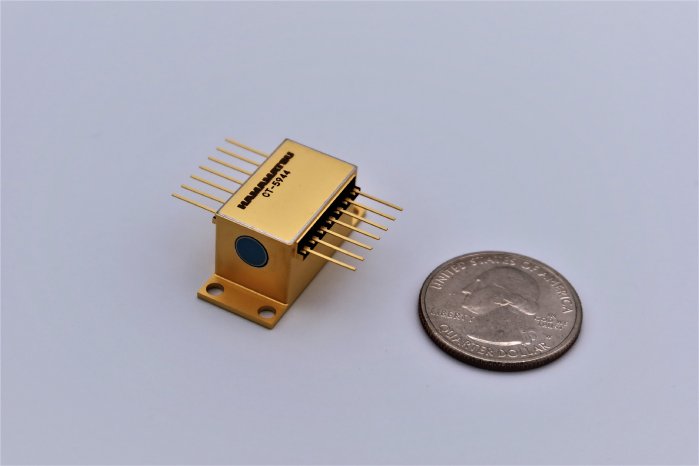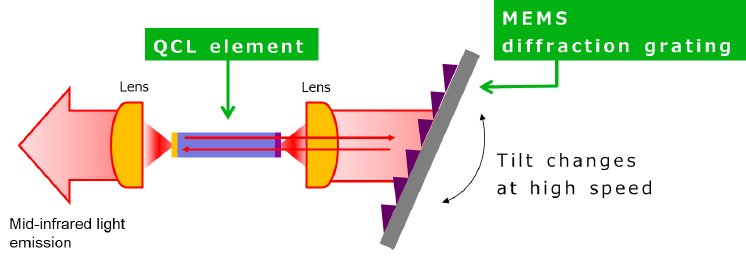This breakthrough stems from the “Development of sensing technology for detecting extremely weak signals to realize an IoT society” project supported by the New Energy and Industrial Technology Development Organization (NEDO), Japan’s largest national research and development agency. Combining this new QCL with a drive system developed by the National Institute of Advanced Industrial Science and Technology (AIST) will help achieve high-speed operation and simplify the peripheral circuit design, allowing it to be mounted into equipment as a light source in portable analyzers. This will make the analyzers small and lightweight enough to carry anywhere.
This project also aims to increase analyzer sensitivity for detecting sulfur dioxide (SO2) and hydrogen sulfide (H2S) as well as simplifying maintenance. Doing so, will allow its use in applications for stable long-term monitoring of volcanic gas components near the craters of volcanoes. Other promising applications include detecting toxic gas leaks in chemical plants and sewers as well as making atmospheric measurements.
Overview
Techniques for predicting volcanic eruptions usually rely on monitoring the concentration of sulfur dioxide (SO2) or hydrogen sulfide (H2S) in volcanic gases that tends to rise a few months before an eruption. Most research institutes therefore currently utilize gas analyzers with an electrochemical sensor that detects target gases by way of electrodes. Researchers install these gas analyzers near volcano craters to analyze those volcanic gas components in real-time. However, since the electrodes of the electrochemical sensors are in close contact with volcanic gases, their performance deteriorates causing a short service life. These sensors therefore require constant maintenance including part replacement, which makes it difficult to perform stable long-term monitoring. On the other hand, all-optical gas analyzers using a long-life light source and light detector need less maintenance and can analyze gas components with high sensitivity and high stability over a long period of time. However, all-optical gas analyzers are usually large because the light source takes up a lot of space, making it difficult to install those analyzers near volcano craters.
To solve this problem, from 2020 as a part of the “Development of sensing technology for detecting extremely weak signals to realize an IoT society *1)” project supported by the New Energy and Industrial Technology Development Organization (NEDO), Hamamatsu Photonics and the National Institute of Advanced Industrial Science and Technology (AIST) have been doing R&D work on a next-generation volcanic gas monitoring system that is an all-optical compact unit with high sensitivity and easy maintenance.
In this project, Hamamatsu Photonics were given the role of designing a miniaturized light source for gas analyzers and has now succeeded in developing the world’s smallest wavelength-swept QCL*3) capable of emitting mid-infrared light *2) while changing its wavelength at high speed in a range from 7 to 8 micrometers (micrometer or μm is one-millionth of a meter). (See Figures 1 and 2 and Table 1). Combining this new QCL with a drive system developed by AIST will help achieve high-speed operation and simplify the peripheral circuit design, allowing it to be mounted into portable analyzers as the light source. These analyzers can now be made small and lightweight enough to carry anywhere. In this project, we are also conducting research to increase the analyzer sensitivity and minimize maintenance with the aim of stable long-term monitoring of volcanic gases near volcano craters. Other promising applications include detection of toxic gas leaks in chemical plants and sewers as well as atmospheric measurements.
Our current results
【1】The world’s smallest wavelength-swept QCL about 1/150th the size of previous products
Harnessing our unique advanced MEMS technology, we completely redesigned the MEMS diffraction grating*4) that takes up the most space in the wavelength-swept QCL and succeeded in developing an innovative MEMS diffraction grating that is about 1/10th the size of conventional MEMS diffraction gratings. We also employed a small magnet and arranged it to reduce unnecessary space, while assembling other components with high accuracy down to units of 0.1 μm. The result of all these efforts is the world’s smallest wavelength-swept QCL that is only about 1/150th the size of previous products.
【2】Emits mid-infrared light while periodically changing its wavelength in a range from 7 to 8 μm
This wavelength-swept QCL emits mid-infrared light in a wavelength range from 7 to 8 μm which is easily absorbed by SO2 and H2S. This was made possible by mounting the QCL element we recently developed based on quantum structure design technology *5) accumulated over many years. At the same time, we also developed a wavelength tunable QCL that is able to emit mid-infrared light at a specific wavelength selectable in a range from 7 to 8 μm.
【3】Allows acquiring a continuous mid-infrared spectrum at high speed
Combining this wavelength-swept QCL with the drive system, developed by the AIST Sensing System Research Center, achieves high-speed wavelength sweeping capable of acquiring a continuous mid-infrared light spectrum within 20 milliseconds. Acquiring the spectrum at high-speed allows analyzing transient phenomena that change at high speed over time.
Future approaches
Hamamatsu Photonics, in cooperation with NEDO and AIST, will be working to build a compact, next-generation volcanic gas monitoring system equipped with our currently developed wavelength-swept QCL. We will also proceed with demo experiments such as multipoint observations. In parallel, we plan to release module products within 2022 that utilize wavelength-swept QCL and drive circuits in combination with our photodetectors to further expand mid-infrared light applications.
[NOTES]
*1: Development of sensing technology for detecting extremely weak signals to realize an IoT society
R&D themes:Development of sensing technology for detecting extremely weak signals to realize an IoT society, Achievement of innovative sensing technology, R&D for next-generation volcanic gas disaster prevention technology using wavelength-swept mid-infrared laser
Project overview: https://www.nedo.go.jp/...
*2: Mid-infrared light
Mid-infrared light is a type of infrared light at wavelengths longer than visible light and generally lies in a wavelength range from 4 to 10 μm.
*3: Wavelength-swept QCL (Quantum cascade laser)
Quantum cascade lasers or QCL are semiconductor laser light sources, which have a quantum structure in the light-emitting layer that enables them to produce high-power light in the mid-infrared to far-infrared region of the spectrum. Wavelength-swept quantum cascade lasers utilize a MEMS diffraction grating that disperses and reflects mid-infrared light from the quantum cascade laser and emits mid-infrared light while rapidly shifting the wavelength by electrically controlling the MEMS diffraction grating to change its angle at high speed.
*4: MEMS diffraction grating
A subminiature diffraction grating that operates by passing an electric current. A diffraction grating is an optical element that separates light into its component wavelengths by utilizing the fact that the light refraction angle differs according to wavelength.
*5: Quantum structure design technology
This is device design technology utilizing the quantum effect that occurs from laminating nano-level thin film semiconductors. The wavelength-swept QCL we developed uses a unique anti-crossed dual-upper-state design (AnticrossDAU TM) for the light-emitting layer of the QCL element.




